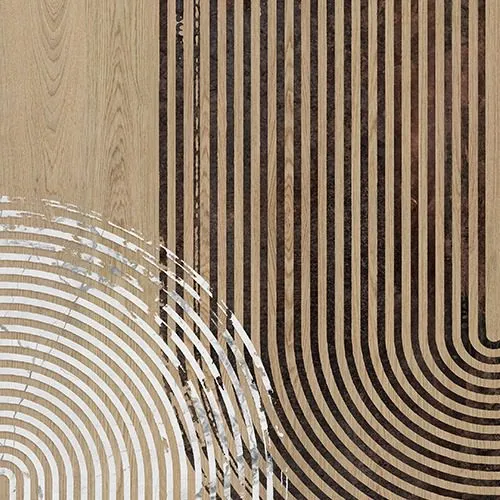Porcelain tiles are a type of ceramic tile that has gained immense popularity in both residential and commercial settings due to their exceptional durability, versatility, and aesthetic appeal. They have a fantastic water absorption rate of 0.5% or less as defined by EN 14411. These tiles are known for their hardness, water resistance, and low maintenance requirements, making them an excellent choice for various applications. This comprehensive discussion will delve into the history, manufacturing process, properties, advantages, and applications of porcelain tiles. We will also explore some design trends by Aximer, the best porcelain tile supplier in Dubai and all over the UAE.

History of Porcelain Tile
Porcelain as tile has a rich history that dates back to ancient China. The term "Porcelain" comes from the Italian word "Porcellana", which means "Seashell", owing to its smooth, glossy appearance. The origins of porcelain can be traced back to the Han dynasty (206 BC to 220 AD) when the Chinese began developing high-fired ceramics with a vitreous quality.
The art of porcelain-making eventually spread beyond China's borders, with European countries establishing their porcelain industries in the 18th century. Since then, porcelain has continued to evolve, and its production methods have been refined, leading to the development of modern porcelain tiles that we use today.
 Aximer Ceramic Porcelain Tiles and Slabs Supplied for Floors and Walls[/caption]
Aximer Ceramic Porcelain Tiles and Slabs Supplied for Floors and Walls[/caption]
Porcelain Tiles Manufacturing Process
The manufacturing process of porcelain tiles involves several key steps, each of which contributes to the final product's quality and characteristics:
1. Raw Material Selection
The primary materials used in production include special kaolin clay, feldspar, silica, and other natural minerals. The precise composition and selection of raw materials play a vital role in determining the tile's properties.
2. Mixing and Grinding
The raw materials are mixed in precise proportions and ground into a fine powder. This mixture, known as the "body" or "biscuit", forms the tile's base.
3. Shaping
The body is then shaped into tiles using various methods, such as extrusion, pressing, or casting. Pressing is the most common method, where the powdered body is compressed under high pressure to form the desired tile shape.
4. Drying
The newly shaped tiles undergo a drying process to remove excess moisture. This is a critical step to prevent warping or cracking during firing.
5. Firing
The dried tiles are fired in kilns at extremely high temperatures, typically ranging from 1200 to 1300 degrees Celsius (2200 to 2400 degrees Fahrenheit). This process vitrifies the tile, making it highly dense and impervious to water.
6. Glazing (optional)
Porcelain tiles may undergo glazing to enhance their appearance or add specific design elements. Glazing involves applying a thin layer of glass-like material to the surface of the tile, which can be matte, glossy, or textured.
7. Cooling and Inspection
After firing, the tiles are cooled slowly to prevent thermal shock. They are then carefully inspected for defects, ensuring only high-quality tiles are selected for sale.
Porcelain Tiles Properties
Porcelain tiles possess several notable properties that contribute to their widespread use and popularity:
1. Water Resistance
Due to their low porosity, these tiles are highly water-resistant. This property makes them suitable for bathrooms, kitchens, swimming pools, and other wet areas.
2. Stain Resistance
The low porosity also makes them resistant to staining, making them easy to clean and maintain.
3. Frost Resistance
Porcelain tiles are frost-resistant, making them suitable for outdoor installations in cold climates.
4. Durability
Porcelain tiles are exceptionally durable, making them ideal for high-traffic areas like hotels, offices, or outdoor installations. Their hardness and resistance to abrasion ensure that they retain their original appearance for many years.
5. Fade Resistance
UV rays from the sun can cause fading and discoloration in some materials. Outdoor tiles are designed to resist fading, ensuring their color remains vibrant over time.
6. Fire Resistance
These porcelain stoneware tiles are non-combustible, making them a safe choice for both residential living rooms and commercial applications.
7. Scratch Resistance
They are highly scratch-resistant, making them suitable for areas with heavy foot traffic or where furniture may move frequently.
8. Low Maintenance
Thanks to their durability and stain resistance, porcelain tiles require minimal maintenance, usually just regular cleaning with mild detergent and water.
9. Hygienic
Porcelain tile's smooth and non-porous surface makes it inhospitable to bacteria, allergens, and mold, promoting a healthier living environment perfect for spaces like bedrooms.
10. Allergen-Free
Unlike carpeting, which can trap allergens, porcelain tiles offer an allergen-free flooring option.
11. Variation in size
Porcelain tiles come in a wide range of sizes, offering flexibility and creativity for various design projects. The most common sizes for square porcelain tiles are 60x60 cm, 80x80 cm, and 100x100 cm. Large-format porcelain tiles (or called slabs), such as 120x280 cm or 160x320 cm, have gained popularity for their ability to create seamless and visually spacious installations.
The variety of porcelain tile sizes allows designers and homeowners to achieve diverse aesthetics, from classic and traditional to modern and contemporary, making them a versatile choice for any interior or exterior space.
12. Variation in thickness
Porcelain tiles are available in a range of thicknesses, each serving specific purposes and applications. The most common thickness for standard porcelain tiles used in interior spaces is 8 to 10 millimeters (mm).
These thinner tiles are suitable for residential flooring and wall installations, offering a sleek and elegant appearance. For more heavy-duty applications or areas with high foot traffic, thicker porcelain Tiles, such as 12 to 20 mm, are preferred to ensure enhanced durability and resistance to wear.
Additionally, thicker porcelain tiles are commonly used for outdoor and commercial projects due to their ability to withstand harsher conditions. Ultimately, the choice of porcelain tile thickness should be based on the specific requirements of the project, balancing aesthetics, practicality, and the level of traffic the tiles will encounter.
 Aximer Stone Effect Porcelain Stoneware | Grace | Floors and Walls | UAE[/caption]
Aximer Stone Effect Porcelain Stoneware | Grace | Floors and Walls | UAE[/caption]
Advantages of Porcelain Tiles over Classic Ceramic Tiles
Porcelain tiles and slabs are both popular choices for flooring and wall coverings, but they have some critical differences in terms of composition, durability, water absorption, and applications:
Composition
The primary difference between porcelain tiles and ceramic tiles is their composition. Porcelain tiles are made from a more refined and denser clay that is fired at higher temperatures. Ceramic tiles, on the other hand, are made from a mixture of various clays and other natural materials, with a lower firing temperature.
Water Absorption
Porcelain tiles have a lower water absorption rate (typically 0.5% or less) compared to ceramic tiles (which can range from 3% to 7%). The low water absorption of porcelain tiles makes them more resistant to moisture and stains, making them ideal for areas like bathrooms and kitchens.
Density and Durability
Due to the differences in composition and firing, porcelain tiles are denser and more complex than ceramic tiles. This makes porcelain tiles more durable and resistant to scratches, chipping, and wear, making them suitable for high-traffic areas and outdoor use.
Stain Resistance
The low porosity of porcelain tiles makes them less susceptible to stains compared to ceramic tiles. This attribute is precious in areas prone to spills or staining agents.
Applications
Porcelain tiles are highly versatile and suitable for both indoor and outdoor use. Their superior durability and frost resistance make them an excellent choice for exterior applications as well. Ceramic tiles are typically used for indoor applications and areas with lower traffic.
In summary, these tiles are more durable, water-resistant, and versatile compared to ceramic slabs or tiles, which makes porcelain tiles suitable for a broader range of applications and environments, like the hot climate of the UAE. However, both types of tiles have their merits, and the choice between porcelain and ceramic ultimately depends on the specific needs, budget, and aesthetic preferences of the project.
Applications of Porcelain Tiles
Porcelain tiles and slabs find a wide range of applications in residential, commercial, and public spaces, owing to their durability and versatility:
1. Residential Use
Porcelain tiles are commonly used in residential applications for floors, walls, bathrooms, kitchens, entryways, and even outdoor patios and pool decks. Porcelain tile flooring is an excellent choice for homeowners and businesses looking for a durable, attractive, and low-maintenance flooring option.
2. Commercial Use
In commercial settings, porcelain tiles are favored for their ability to withstand heavy foot traffic and maintain their appearance over time. They are commonly used in shopping malls, hotels, restaurants, offices, and airports.
3. Swimming Pools
These tiles are designed for pool areas and offer slip resistance and durability in wet conditions.
4. Exterior Cladding
Large-format Porcelain Tiles with enhanced durability and weather resistance are used for exterior cladding to create visually stunning facades.
5. Countertops and Backsplashes
These tiles are suitable for kitchen and bathroom countertops, as well as backsplashes, due to their stain resistance and hygienic properties.
6. Outdoor Use
Outdoor Use of Porcelain Tiles is a fantastic choice for transforming outdoor spaces into beautiful and functional areas. Their ability to withstand various weather conditions, slip resistance, and low maintenance make them a practical and beautiful choice for patios, decks, walkways, and other outdoor areas. They share many characteristics with indoor ones but are specially designed to withstand the challenges posed by the elements.
7. Public Spaces
These tiles are used in public spaces like museums, hospitals, educational institutions, and government buildings due to their low maintenance requirements and longevity.
 Porcelain Tile | Marble-Look 1 | Exotic | Aximer Stoneware | Dubai, UAE[/caption]
Porcelain Tile | Marble-Look 1 | Exotic | Aximer Stoneware | Dubai, UAE[/caption]
Design Trends for Porcelain Tiles: Looks & Effects
The world of Porcelain slabs & tiles is continuously evolving, influenced by changing design trends and consumer preferences. Some popular looks and effects for design trends in porcelain tiles include:
1. Concrete Effect
Inspired by industrial design, concrete-look porcelain tiles provide a modern and minimalist appearance, often with subtle texturing and color variations.
2. Wood Look (Effect)
Mimicking the appearance of natural wood, wood-look porcelain tiles have gained popularity for their warmth and texture while offering the durability of porcelain.
3. Decorative Patterns
Decorative Porcelain tiles featuring contemporary and geometric patterns or intricate designs add a touch of artistry and visual interest to spaces.
4. Marble-Look and Stone-Look Effect
Porcelain tiles with marble-look and natural stone-look effects have become increasingly popular as they offer a cost-effective alternative to genuine marble or stone with added durability.
5. 3D and Relief Porcelain Tiles
Three-dimensional and relief porcelain tiles add depth and dimension to walls, creating stunning visual effects most suitable for accent walls.
Porcelain Tiles and Slabs by Colors
Porcelain Tiles and Slabs both offer limitless options for colors. Here are some examples:
White Porcelain Tiles
White porcelain tiles are a timeless and elegant choice for various interior design projects. Their clean and pristine appearance adds a sense of sophistication and serenity to any space. Whether used for flooring, walls, or countertops, white-colored tiles create a versatile canvas that complements a wide range of design styles, from modern minimalism to classic elegance.
Black Porcelain Tiles
Black porcelain tiles are a sophisticated and versatile flooring option that effortlessly adds elegance and modernity to any space. Their sleek and polished surface reflects light beautifully, enhancing the overall ambiance of the room. Whether used in bathrooms, kitchens, living areas, or commercial settings, black-colored ones offer a timeless appeal that complements various design styles, from contemporary to classic.
Grey Porcelain Tiles
Porcelain tiles in grey offer a sophisticated and contemporary look that has gained popularity in modern interior design. The subtle and neutral tones of grey create a versatile backdrop that complements various color palettes and decor styles. Grey Porcelain Tiles are often chosen for their ability to add a sense of calm and tranquility to spaces, making them perfect for creating relaxing environments in homes and commercial settings alike.
Cream Porcelain Tiles
Cream porcelain tiles embody the epitome of understated elegance and versatility. The neutral and soothing cream tones effortlessly blend with various interior styles, lending a timeless charm to any space. Whether used in bathrooms, kitchens, living areas, or commercial settings, beige-colored tiles add a touch of sophistication and warmth.
Conclusion
Porcelain tiles and slabs have come a long way since their ancient Chinese origins, evolving into a versatile and durable flooring and wall covering option suitable for a wide range of applications. Their history, manufacturing process, properties, and design options all contribute to their widespread use and popularity in both residential and commercial settings.
Porcelain tiles are a well-known choice for flooring and wall coverings in many places, like the UAE. These stonewares in Dubai, Sharjah, or Abu Dhabi are popular due to their durability, versatility, and aesthetic appeal. Whether replicating the look of natural materials like wood and stone or showcasing bold and artistic designs, these tiles continue to push the boundaries of creativity and aesthetics in interior and exterior design. As technology advances and design trends evolve, we can expect porcelain tiles to remain a timeless and sought-after choice for decades to come.
Discover More About Porcelain Tiles and Their Features
Explore our dedicated articles and guides on Aximer Ceramic's Blog Section. Topics Such as Porcelain Slab Tile Types Explained by Look and Applications, Decorative Porcelain Tiles or Slabs, Porcelain Tile Flooring, Porcelain Slab Outdoor Uses, and further insights.




